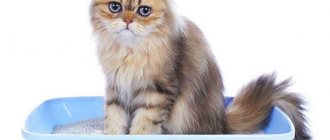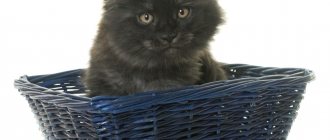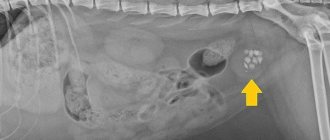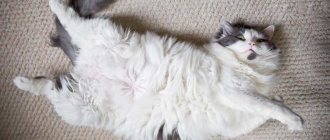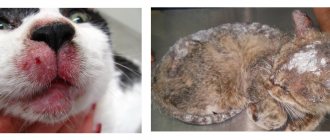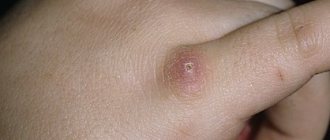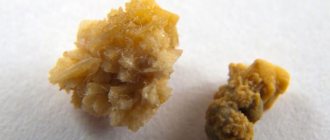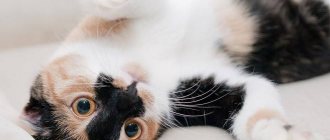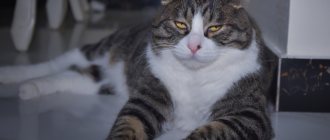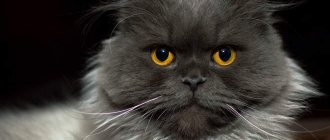Urolithiasis (UCD) or “urolithiasis” is a disease that, according to some data, occurs in 12% of cats. It manifests itself in the formation of stones - uroliths of different chemical nature - in the organs of the urinary system.
Depending on the chemical composition of uroliths (stones), ICD is divided into types:
- struvite,
- oxalate,
- urate,
- cystine or combined type of urolithiasis.
The most common types of disease in cats are struvite, oxalate, and a combined type of disease, in which both struvite and oxalate are found in one animal.
Stones can be found in the bladder, urethra, and less commonly in the ureters and kidneys. The clinical picture of urolithiasis can be observed when there are too many uroliths or they grow to a significant size and interfere with natural urination. In this case, a so-called “urethral plug” is formed, consisting of stones and an organic matrix. It is because of this that cats stop urinating and experience severe pain. Such an obstruction can be fatal to the animal and requires immediate action!
Males are especially susceptible to the disease and serious consequences. This is due to the anatomical structure of the cat's urethra, which is three times narrower than the cat's urethra, and also has an S-shaped bend in the area of the penis. All this can cause obstruction even with small stones.
How to distinguish cystitis from urolithiasis?
It is important to make a correct diagnosis in time, since the diseases have similar symptoms
: pain, frequent urge to urinate, blood in the urine.
The difference between these two diseases is in their nature. Cystitis is an inflammation of the bladder and most often is idiopathic (that is, essentially incomprehensible and unknown) in nature. The most common cause of idiopathic cystitis in cats is stress. Moreover, both hypothermia and the arrival of guests, rearrangement of furniture, change of filling and other things that a person often does not notice can act as a stress factor.
Cystitis in cats often recurs. In this case, you should pay attention to the cat’s habitat, try to eliminate stress factors or help the cat with medication. Various sedatives will help reduce stress: herbal drops, cat pheromones and antidepressants. If the former can be used at home, then you should consult your doctor about prescribing antidepressants. Sufficient water consumption is very important for this disease. Cats naturally drink little, but at home you can offer a variety of fountains with babbling water, bowls of different depths and diameters, as well as special dietary supplements that increase water consumption, for example, PURINA PRO PLAN GYDRA CARE.
Cystitis is a dangerous disease that does not forgive mistakes. Do not delay visiting a doctor if you suspect your pet has symptoms of cystitis. Medicines can prevent the severe consequences of the disease and certainly significantly improve your pet’s quality of life.
Urinary tract diseases
– a common problem in cats related to their anatomy and physiology. In this article we look at urolithiasis - a disease of the lower tract. In addition to urolithiasis and cystitis, there are other diseases of the urinary system, which a veterinarian can diagnose based on the results of an examination. A severe complication of urinary retention of any origin is acute renal failure. Even if the cat has not gone to the toilet for just a day, this can be very dangerous.
Reasons for the development of the disease
Urolithiasis in cats develops for many reasons, which can be divided into two large groups - endogenous and exogenous. Most often, the disease is provoked by external factors, so the pet owner is usually to blame.
External factors
This group of reasons for the development of ICD includes:
- Wrong diet. Unsuitable food or lack of drinking water are common problems. The use of ready-made cheap feed and the animal’s lack of access to water are unacceptable. Many people don’t even realize that boxes of cat food on store shelves cause urolithiasis. Due to lack of water, urine becomes more concentrated, its pH changes and urinary stones begin to form.
- Poor quality water and climate. In hot climates, urination increases, and lack of water or lack of access to it creates the same effect as described above. Poor-quality tap water with large amounts of heavy metal salts and other impurities is harmful to cats.
- Avitaminosis. A deficiency of vitamin A, essential for healthy skin and mucous membranes, causes great harm. Against the background of hypovitaminosis, the condition of the urethral mucous membranes deteriorates.
Internal factors
There are several internal causes leading to urolithiasis, namely:
- Hormonal imbalances. Lead to disruption of material metabolism and the formation of stones. In normal conditions, the urethra in cats is narrow and long, and each deformation or pathology creates conditions for the development of urolithiasis. Almost any malfunction in the gastrointestinal tract and a violation of the acid-base environment in the urine are provoking factors.
- Cystitis, obesity, lack of mobility - all these factors are also dangerous to the health of cats. A typical patient in veterinary clinics are cats under 5 years of age, fluffy and overweight, who do not go outside and are constantly half asleep, and also eat inexpensive dry ready-made food.
- Heredity. There are pets that are predisposed to the disease, and all other factors only increase the likelihood of developing urolithiasis.
What causes struvite and oxalate type urolithiasis?
Struvite
in the bladder of cats, they usually form in young age, and oxalates - in middle age. In general, cats from 1 to 10 years old suffer from ICD. In kittens and older cats, the struvite type of urolithiasis occurs, caused by infection. In adult cats, oxalate urolithiasis is more common, and in adult cats, struvite stones are more common. Urinary tract obstruction is more common in cats.
The formation of struvite may be associated with inflammation or the presence of infection, as well as with an excess of magnesium, phosphorus, calcium, chlorine, and nitrogen compounds in the diet. Bacteria of the genus Staphylococcus and Proteus can cause struvite type of urolithiasis (especially in young cats).
Oxalates
are more often formed with a deficiency of potassium and sodium in the diet, as well as with overfeeding and obesity. Cats are predisposed to the oxalate type of urolithiasis, especially sterilized cats that live indoors and lead a sedentary lifestyle. Oxalates, unlike struvite, can be found in the kidneys. This disease is more common in older cats, 10-15 years old.
Prevention
Prevention of urolithiasis in cats:
- ensuring constant access to clean water;
- feeding balanced food. Sterilized pets must be fed specialized prepared food;
- preventing hypothermia;
- taking vitamins;
- weight control;
- physical activity and regular play. Exercise stimulates kidney function and normalizes metabolism;
- Regular visits to the veterinary clinic to diagnose possible problems.
Urolithiasis in cats is a pathology that has serious consequences. Be attentive and caring to your pet, because it is easier to prevent a disease than to treat it over a long period of time.
What influences the development of urolithiasis?
- Genetic, metabolic factors
- Violation of the drinking regime. Animals that do not consume enough fluids are at high risk.
- Heat. Exacerbation of urolithiasis can occur in hot weather, when urine becomes most concentrated.
- Creating a favorable environment for crystal growth - for example, increasing the concentration of urine if the animal has been patient for some time and has not gone to the toilet (for example, because the tray is dirty).
- Hormonal imbalance, including disruption of the thyroid gland due to a lack of iodine in the diet.
- The use of certain medications that promote stone formation (sulfonamides, calcium preparations, etc.)
As you can see, the reasons are very different, and not all can be influenced by animal owners. But some can still be taken under control: proper feeding of pets, avoidance of obesity and adherence to drinking regime
.
Silence is not always golden?
For a long time, the stone may not show itself in any way. But this is not dangerous only in those rare cases when stones can be considered “clinically insignificant” - they are not only “silent”, but also do not impair kidney function for many years. However, everything is for the time being, so such patients need to periodically visit a urologist.
A kidney stone makes itself felt with an attack of renal colic. When it happens depends not at all on its size, as many people think, but on where exactly the stone settled, whether it blocked the outflow of urine and other factors.
What are the symptoms of urolithiasis in cats?
Symptoms of urolithiasis do not appear immediately. At the onset of the disease, small crystals in the bladder can only be detected by chance during a routine examination (ultrasound or urinalysis). Then there are more crystals or they increase in size and begin to injure the walls of the bladder or urethra. The cat experiences pain and problems urinating.
What should immediately alert the owner?
- The pet often goes to the toilet, and urine is released in small portions or not at all.
- Urine becomes more concentrated, may acquire a pungent odor, and contains blood.
- Each urge to urinate is accompanied by pain and meowing.
- The cat begins to go to the toilet in the wrong places, urinate on the bed or in the middle of the room, even if such behavior was not noticed before. The reason for this is pain.
- The pet becomes lethargic, indifferent, stops eating or eats very little, even from its favorite food.
- If urination does not occur, the bladder increases in size, the pet's belly becomes round, tight and painful. This condition is very dangerous, since at this moment the amount of harmful metabolic products in the blood, which are normally excreted in the urine, increases. The electrolyte balance is disturbed. This complication is called acute renal failure, in which the pet falls into lethargy, body temperature and blood pressure drop, and the animal is on the verge of death. Of course, it is better not to bring the cat to this state, and home help in such a situation is already useless. The animal must be urgently taken to the clinic.
Features of the disease
KSD is a chronic pathology: the animal develops salt deposits in the form of stones or sand in the kidneys, urinary ducts, and bladder. Every fourth individual is at risk of experiencing these symptoms. Animals from two to six years old, cats with impressive weight, breeds with long hair, castrated males and unsterilized females are susceptible to the disease.
Manifestations
Males experience the pain of passing stones or sand more often, since their urethra is much narrower than that of females. Periods of exacerbation include the beginning of autumn, as well as the time from January to April.
At first, the disease is not noticed because it does not manifest itself. However, further formations will only increase in size, and one day a moment will come when the formation will move away from the wall of the bladder or kidney and begin to move with the flow of secretions.
Even the smallest formation causes extreme pain to the cat, causing mechanical damage to the delicate surface of the urethra. Impressive-sized salt formations can clog the urinary duct - this is called obstruction. The fluid stagnates, burning pain and intoxication appear. In this case, prompt emergency assistance must be provided, otherwise the animal will simply die.
Types of formations
ICD manifests itself in two types of formations: struvite and oxalate. For the first, an alkaline environment is needed - if there is an excess of phosphorus and magnesium in the body, then the urine becomes alkaline. Struvite has a harder structure.
Oxalates are formed if the urine pH is very acidic. It is caused by high amounts of calcium. Oxalates are special in that they have sharp edges and a loose structure.
How to provide first aid to a cat with urolithiasis?
1. Relieve pain
First of all, the animal needs to be given pain relief. Many drugs used for pain relief in human medicine are toxic to cats. For example, tablets containing paracetamol or ibuprofen. From the home medicine cabinet, a good remedy may be no-spa, papaverine or banal analgin. A medium-sized cat can be given 1/4-1/5 tablets.
Herbal preparations such as cystone, canephron, urolesan or its analogues, stop cystitis for cats can also be useful in the initial stages of the development of the disease.
2. Monitor your pet's bladder emptying
If there are several cats in the house, this task can be difficult. If your pet does not urinate for several hours, but still goes to the litter box and experiences endless urges, contact your veterinarian.
3. Show the animal to the doctor
To make a diagnosis, the doctor will analyze the medical history (information from the owner) and examine the animal. Sometimes ultrasound and urine analysis are sufficient for diagnosis. Blood tests are needed to assess the extent of kidney dysfunction.
Is stone removal only surgical?
- Most often, such patients undergo cystotomy (abdominal surgery with an incision in the bladder) to remove stones, which are subsequently sent for research. This is the fastest and easiest method, used by most surgeons.
- Cystoscopy is considered a less invasive method. Flexible thin endoscopic instruments (cystoscopes) are used. This method of stone removal is indicated only for small stones, and is performed only on cats (females). Laser lithotripsy is sometimes used to break up large stones, in which case, if the procedure is successful, the stones may turn into sand and pass on their own, or they can also be removed endoscopically. In the Russian Federation, laser lithotripsy is performed in a few clinics and is not considered necessary due to the availability of simpler methods and the high cost of this procedure.
- If the diameter of the stones is small enough that they are actually sand, you can try bladder lavage under sedation. The patient is given anesthesia, a urethral catheter is installed, and the bladder is washed with Sodium Chloride. You can place the patient vertically, head up, then under the force of gravity and pressure from the solution, the stones can pass through the urethra through the catheter. This procedure is carried out quite rarely, as it has rather low efficiency.
- In the presence of massive stones, a diet for dissolving sand in the bladder is not indicated; it simply does not work.
- Each stone removed must be sent to a laboratory for diagnosis. The goal is to prevent and prevent urolithiasis in the future.
- If we are talking about the presence of stones in the renal pelvis or ureter, removal at the moment is only surgical. In consultation with your treating surgeon, ureteral stenting (installation of a stent to prevent narrowing of the ureter and normalize the passage of urine into the bladder) may be performed.
As a rule, getting a stone is a simple task. It is much more difficult to prevent the development of urolithiasis in the future. If the patient is one of the 35% of animals with hypercalcemia, it is necessary to examine him more carefully to find out what was the root cause of the increased calcium content in the body.
What could be the treatment?
Treatment of urolithiasis can be conservative or surgical. Since we often cannot influence the true cause of the development of KSD, this disease is prone to relapse. The attack may occur without blockage of the urinary tract or with complete obstruction. The first thing to do if the outflow of urine is disrupted is to evacuate it from the bladder. This is done using a catheter or, if it is impossible to install a catheter, by puncturing the bladder. The urethral catheter is sometimes left in place for several days and the owner is given clear instructions for care.
In severe cases, such a patient requires hospitalization, since without full fluid therapy it is impossible to correct renal and electrolyte parameters. However, more often, after prescriptions from a doctor, the cat is sent home with the owner for outpatient treatment.
The treatment regimen for urolithiasis includes
- painkillers in tablets, drops or injections,
- means for relaxing the muscles of the bladder and urethra,
- sedatives
- special diet.
As a relaxant of the smooth muscles of the urinary tract
, you can use cornam (terazosin). But in cats at high risk of urethral obstruction, this drug is prescribed with caution.
Diuretics
, as a rule, are not used. This is because with this disease there are no problems with urine formation and there is no need for stimulation. On the contrary, diuretics can worsen the pet’s condition by accelerating the process of dehydration and intoxication.
Antibiotics
They are not used primarily in treatment, since this disease is rarely complicated by a bacterial infection. The basis for antibiotic therapy is usually the results of urine culture. In the laboratory, analyzing the sample, they isolate bacteria that complicate the course of the disease and select antibacterial drugs to which these bacteria are sensitive. This could be sinulox, furagin, furadonin or other medications in tablets or injections. Dexamethasone and similar hormonal drugs are not used in the treatment of urolithiasis in cats.
When prescribing treatment, it is important to know which type of salt caused the urolithiasis. Struvite crystals respond well to lysis (resorption) with the help of a special diet. With the oxalate type of urolithiasis it is more difficult; it is important to prevent the growth of crystals and ensure normal urination.
Elimination of poisoning in urolithiasis
Elimination of poisoning due to urolithiasis is carried out in two stages
First. Toxins are bound with certain drugs, such as glutargin or glucose solution 5%. Second. Drugs are prescribed to stimulate the functioning of liver cells, for example Essentiale. The body is supported by a set of measures. Stop bleeding with hemostatic drugs. If necessary, stop vomiting with metoclopromide. If abnormalities in the functioning of the heart are detected, appropriate medications are used. Mildronate, Prestarium, etc. are used to support the work of the heart muscle, and sulfocamphocaine is used to stimulate the heart.
Treatment of urolithiasis takes a long time, and prevention is generally lifelong. Because relapse of the disease is possible in 80% of cases, and the disease will develop faster and faster. The best way to prevent illness in a cat is diet. Give your pet fish once a week, limit the consumption of salt and meat. If possible, switch only to dry or canned food. Once every 3-4 months they give special food to prevent urolithiasis. You should also not forget to test your urine every 2-3 months. If crystals are found in the sediment, then drugs are prescribed to dissolve them.
What to do if treatment does not bring results?
If conservative treatment is ineffective in cats with recurrent urethral blockage, surgery is performed - urethrostomy. The essence of the operation is that the cat's urethra is made straight and wide, like a cat's. As a result, sand and small stones no longer get stuck in the narrow S-shaped section of the male’s urinary tract, but are washed out with a stream of urine.
Caring for a cat after surgery involves treating the stitches and preventing them from licking. A cat's rough tongue can prevent sutures from healing and inflammation from the delicate skin at the site where they are applied. Therefore, the cat must wear a special protective collar throughout the healing period, and the stitches must be treated with water-based antiseptic solutions as recommended by a doctor.
How does ICD manifest itself?
It is almost impossible to determine that your four-legged friend has urolithiasis at the initial stage of its development. The animal will not complain to you about discomfort or difficulty urinating. Accordingly, owners become aware of the problem when it is far advanced. You cannot postpone a visit to the veterinarian if:
- The cat stopped going to his usual place to go to the toilet, but goes wherever he wants.
- Too little urine is produced, and particles of blood or grains of sand are found in it.
- The urge to urinate becomes more frequent.
- Pain caused by sand in the urinary tract forces the cat to constantly lick the urethra.
Gradually, the animal’s body temperature rises to 40 degrees, it stops eating and moves less. When the urine stops moving along the paths, the cat becomes very restless, meows and takes a pose as if he is going to relieve himself, but nothing comes of it.
It is especially important to urgently go to the veterinarian if the animal is in critical condition, which is manifested by the following signs:
- the stomach has become denser and increased in size;
- urine does not come out, but stagnates in the urinary tract and leads to tissue intoxication;
- the cat sits almost motionless;
- foamy saliva is released;
- the pet's body is trembling;
- vomiting appeared.
If there is no timely help for such symptoms, the animal may die.
What does modern veterinary medicine and Purina offer to solve the problem?
Veterinary medicine is a rapidly developing science. In the modern world, the standards for treating diseases have changed greatly, compared to even 5 years ago. Previously, in the absence of knowledge and capabilities in the field of diagnosis and treatment of urolithiasis, they tried to fight this serious disease with the help of folk remedies or drugs that are not only useless, but can also harm the animal or delay real treatment and lead to serious consequences.
A big discovery in recent years has been dietary diets that can correct the condition of cats with urolithiasis or prevent the disease and its relapses. For example, PRO PLAN® VETERINARY DIETS UR ST/OX URINARY FOR CATS WITH DISEASES OF THE LOWER URINARY TRACT allows you to dissolve struvite stones and prevent the growth and formation of oxalates.
These foods promote the production of undersaturated, not very concentrated urine and therefore prevent the formation of crystals. Moderate fat and calorie content allows you to maintain normal body weight. The food is recommended for the treatment of urolithiasis and prevention of relapses and can be used for a long time. Knowing the capricious nature of cats, diet companies produce products with different tastes. The food can be based on meat, fish or chicken protein. With a homemade diet, it is almost impossible to balance a complete diet for a cat with urolithiasis. There are no products that would help dissolve stones and be complete and usable for cats. Meat contains too much magnesium, phosphorus and protein, milk has a high calcium content. But the mineral composition of the diet is especially important for cats with diseases of the lower urinary tract!
We have already said that urolithiasis in cats has many causes. The owner’s task is to eliminate those causes that he can influence. A nutritious diet containing vitamins and minerals in the right quantities is the key to your pet’s health. For indoor cats that have been spayed or neutered, it is also important to maintain an ideal body weight. Obesity increases the risk of many diseases, including cystitis and urolithiasis.
Proper drinking regime is also extremely important.
pet. Cats, by their nature, are animals accustomed to retaining fluid in the body in conditions of its deficiency. Therefore, a domestic cat fed wet food or a diet from the owner's table may drink very little or not drink at all. However, milk or cream is not considered a complete drink. If your cat is fed a commercial dry diet, she definitely needs to drink water. Therefore, be sure to always ensure that there is clean water in your animal’s bowl - cats are very sensitive to the freshness of water. The cat will not drink liquid contaminated with food or, for example, dog saliva. Therefore, the water bowl should be kept away from the food bowl.
Many cats prefer the babbling stream of tap water. Such animals will enjoy various fountains that stimulate thirst. Developed by Purina, PURINA® PRO PLAN® Hydra Care is served in a separate bowl to complement the main diet and helps increase your cat's overall fluid intake.
And if your pet has already had an attack of urolithiasis, specially developed test systems - cat litter with ICD indication - will help you not to miss a relapse and react in time. This test filler contains substances that allow it to change color depending on the pH (acidity of urine). The color of the filler must be compared with the scale, and as a result you will understand whether there is a risk of recurrence of cystitis or urolithiasis right now.
Causes of ICD
About 12% of domestic cats suffer from this pathology. Moreover, the disease occurs more often in males, which is due to the structural features of the urinary system - they have a narrower urethral lumen than females. Spayed cats and neutered cats aged 2–6 years are also prone to this disease. This is due to postoperative changes in hormonal levels and a slowdown in metabolism. The risk group also includes long-haired breeds and obese animals.
The main factors contributing to the occurrence of ICD are:
- poor diet high in salt or protein;
- poor water quality and/or insufficient quantity;
- systemic diseases (cystitis, urethritis);
- imbalance of mineral and protein metabolism;
- vitamin A deficiency and iodine deficiency;
- sedentary lifestyle;
- obesity;
- decreased immunity;
- constant stress;
- genetic predisposition.
Is it possible to cure urolithiasis in cats?
As a rule, this disease cannot be cured, but surgery can achieve stable remission and eliminate relapses in most cases. Small crystals may form, but they will no longer cause pain and discomfort for the pet, but will be washed away daily by a stream of urine. With the right food/diet, some of the stones can be dissolved and they do not form again. Adequate fluid intake helps prevent urine concentration and inflammation in the bladder. Therefore, cats with ICD can live as long as animals that are luckier, but require more attention from their owners.
What to feed a cat with ICD
When treating a cat for urolithiasis, be sure to use special food for cats with urolithiasis. They have a balanced composition of nutrients, minerals and vitamins. The type of cat food is chosen depending on what stones have formed in the genitourinary system. Natural nutrition is selected individually, but in any case it is recommended to avoid seafood and dairy, as they are saturated with mineral salts.
Diet for oxalate stones
Food should contain a minimum of oxalic acid. If the pet is on homemade food, then offal (liver, kidneys), as well as dairy dishes containing a lot of calcium, should be temporarily excluded. The therapeutic diet includes meat, vegetable stew made from cauliflower, carrots, beets and pumpkin, and rice porridge. If you buy ready-made food for your cat, you need to carefully choose the variety. For oxalate stones, the following is suitable for a cat:
- Hill's Prescription Diet Feline K/D or X/D
- Royal Canin URINARY
- Eukanuba Oxalate Urinary Formula
Hill's Prescription Diet Feline X/D. It has a reduced concentration of calcium and phosphorus, but an increased amount of potassium citrate and soluble fiber. This dietary food should not be fed to pregnant cats, young kittens or cats with struvite crystallization. Hill's Prescription Diet Feline brand K/D is used for stones of any nature.
Royal Canin URINARY is used for both therapeutic and preventive nutrition. It increases urine output and inhibits the formation of stones. The food has limitations - high blood pressure and abnormalities in kidney function.
Eukanuba Oxalate Urinary Formula is a low-calorie dietary food with reduced calcium and fat content. Ingredients are chicken, turkey, egg, cornmeal. Wet food comes with fish. Contraindications include pregnancy, lactation, and under one year of age.
Diet for struvite
Phosphate stones, which form in an alkaline environment, require a change in pH to the acidic side. This is partly facilitated by medicinal food or a properly selected diet of natural products. The cat should not be fed dairy products (cottage cheese, cheese, milk), or egg yolks. It is recommended to prepare dishes from oatmeal, rice, liver, egg whites, lean beef and veal. An alternative could be:
- Hill's Prescription Diet Feline S/D, C/D
- Eukanuba Struvite Urinary Formula
Hill's Prescription Diet Feline S/D is a medicinal food that fully meets the nutritional requirements of this category of cats. The composition contains meat, chicken fat, rice, corn flour, starch. This food should not be offered to small kittens under one year old or pregnant cats.
Eukanuba Struvite Urinary Formula. It is used for struvite crystallization and tendency to fullness. Dry granules are made from corn grits, chicken, turkey, animal fat, and dried eggs. This variety is not given to pregnant and lactating females and small kittens.
Therapeutic techniques
Treatment options exist. The most obvious, although far from the most popular, technique is a surgical “revision” of the bladder : the organ is dissected, the stones are pulled out, and the mucous membrane is washed with a sterile saline solution to completely remove the grains of sand. In principle, many owners delay making a decision until the last minute, because they fear that the operation may lead to negative consequences. But you shouldn’t do this: practice shows that such surgical intervention takes place without complications, and the recovery period after it is quite short. However, it is not always possible to delay.
In cases where a cat has developed urethral obstruction , the only way to save it is to urgently perform surgery . Sometimes it can be delayed, but only in situations where the mucous membrane of the urethra is not swollen, and a catheter is inserted into the lumen of the organ, with the help of which the urolith can be moved and the animal can be given the opportunity to pee. In any case, removal of stones from the bladder is indicated, since the likelihood of recurrence is very high.
